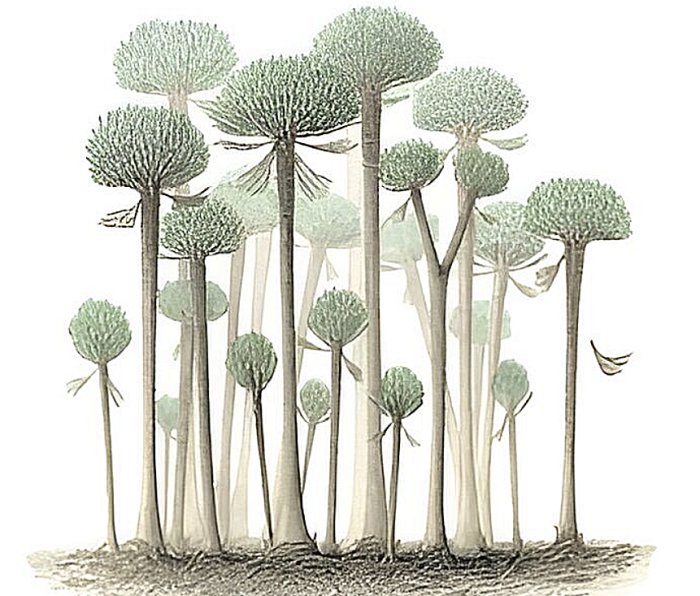Earth’s Earliest Petrified Forest Unearthed On South-West England’s Coast

Conny Waters – AncientPages.com – Researchers have unearthed remnants of what is believed to be the Earth’s most ancient fossil forest on the northern coastline of Devon and Somerset , UK.
A reconstruction of a Calamophyton forest, where trees drawn measure 2–3 meters high. Credit: Peter Giesen/Chris Berry
These trees, estimated to be about 390 million years old, could have been part of a vast forest that once blanketed the eastern coast of what was then known as the Old Red Sandstone continent—a portion of Europe during that era.
The Somerset forest has now been declared 4 to 5 million years older than the former record holder located in Cairo, New York, U.S.
Researchers from Cambridge University made this discovery, which was confirmed at Cardiff University. The unearthed fossils include partial trunks up to 2 meters long and small branches of an early tree species known as cladoxylopsids.
According to the team, cladoxylopsids dominated terrestrial ecosystems for about 5 million years before the advent of more modern woody trees about 385 million years ago.
“These Calamophyton trees are the oldest fossil trees ever found in Britain and represent an as yet missing part of our vegetational history, “Dr. Christopher Berry, a Senior Lecturer at Cardiff University’s School of Earth and Environmental Sciences who identified the fossils, said in a press release.
“The record of fossil forests, where tree bases are preserved where they were living, so far dates back to those discovered in New York State, at Cairo and Gilboa at about 385 million years.
“Although the area of rock exposure is limited and dangerous to access, our new discovery is the oldest clear example of such a geological phenomenon known to date and it speaks directly to the ecology of the oldest forests 390 million years ago.”
The calamophyton trees bear a striking resemblance to palm trees.
These trees were quite unique, having hollow trunks instead of solid ones, with a supportive ring of woody strands encircling the exterior. Their branches didn’t bear leaves but were adorned with countless twig-like formations. These ancestors of modern trees were shorter, growing only to a height between 2 and 4 meters. As they matured, they discarded their lower branches, creating a layer of vegetation debris on the forest floor, forming a perfect habitat for invertebrates.
The remnants of tree bases and toppled trunks found at the site are also important parts of this fascinating discovery, which enables unprecedented insight into these trees’ environmental conditions and arrangement during their lifespan.
“The shape and forms of these structures taken together strongly suggest that these the Calamophyton were standing alongside a raised bank beside a small river channel,” added Dr. Berry.
“I was able to identify the tree trunks based on 30 years studying these types of fossils and particularly having worked on the best and most complete specimens of Calamophyton from Belgium and Germany where they are well known but relatively rare.
“Nevertheless, it was a bit of a shock. Having traveled the world in search of the earliest forests, it is amazing to know that you can see the localities from here on the South Wales coast.”
The team suggests that during the Devonian period, the North Devon and Somerset site was probably situated closer to Belgium and Germany. Later, massive geological shifts like crustal compression and faulting due to Africa’s collision with Europe – ended up in its current location.
“The Devonian period fundamentally changed life on Earth. It also changed how water and land interacted with each other since trees and other plants helped stabilize sediment through their root systems, but little is known about the very earliest forests,” according to Professor Neil Davies of Cambridge University’s Department of Earth Sciences, and the study’s first author.
“The evidence contained in these fossils preserves a key stage in Earth’s development, when rivers started to operate in a fundamentally different way than they had before, becoming the great erosive force they are today.
“People sometimes think that British rocks have been looked at enough, but this shows that revisiting them can yield important new discoveries.”
Written by Conny Waters – AncientPages.com Staff Writer





